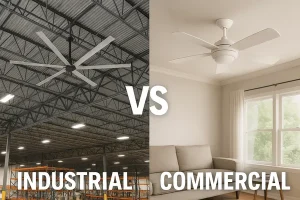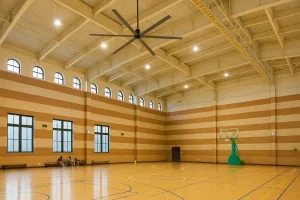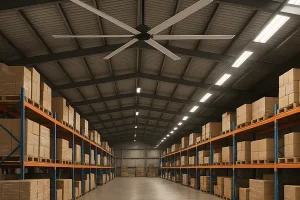Stuffy air and inadequate cooling can sabotage productivity, energy costs, and comfort in large facilities.You watch employees struggle in overheated work zones and see your bills surge each month. Un ventilador industrial o un ventilador comercial provides a strategic fix for flujo de aire and relief—once you understand which is best.
Industrial fans and commercial fans differ in size, construction, and airflow capacity. Industrial models typically operate in more demanding environments with heavier gauge material and welded components for durability, while commercial fans serve lighter-duty tasks. Both type of fan can improve ventilation, but selecting the right option for your facility hinges on space, usage, and performance needs.

ventiladores industriales y comerciales
Understanding the differences between industrial and commercial fans is crucial if you want to make an informed decision for your facility. Think of fanáticos vs systems that either target grandes espacios or smaller espacio comercial. In essence, you can tackle your environment’s scale and demands better when you know how these fans diverge in size, application, and cost.
Cuando comparing industrial and commercial ventiladores, we often look at diferencias clave como aspas del ventilador design, durabilidad, and motor strength. An ventilador industrial usually has more robust construction—Los ventiladores se construyen with higher-grade materials to endure demanding environments como por ejemplo depósito o Instalaciones industriales. By contrast, a ventilador comercial might be lighter, focusing on offices, shops, or schools where usage is less extreme.
The fundamental reason behind this variation lies in the different tasks. Industrial fans and commercial fans handle distinct workloads. Fans serve different purposes because an ventilador industrial has to move a larger volumen de aire and may face higher temperatures or airborne particles in industrial environments, while a ventilador comercial is more about everyday cooling in restaurants, retail spaces, or smaller configuraciones comerciales. This is the difference between the two grades that helps facilities managers focus on fans to create a comfortable climate tailored to their operational requirements.
It’s easy to overlook, but altura del techo is a major deciding factor in choosing between an ventilador industrial y un ventilador comercial. Both ventiladores de techo industriales y ventiladores de techo comerciales come with recommended clearance to optimize movimiento del aire.
When working with ventiladores de techo industriales, you must measure from the floor to the rafters and confirm that you have enough space for safe operation. Los fanáticos suelen ser installed where overhead structures don’t interfere. If your ceiling stands at 25 feet high or more, an ventilador industrial often proves best. Meanwhile, a commercial grade ventilador de techo might do fine in spaces with a lower clearance of, say, 12 to 14 feet.
Floor fans can clutter walkways, especially in a depósito or large store. A suspended ventilador de techo frees up floor space and spreads ventilación more evenly. Ceiling fans compared to floor models often yield better Eficiencia energética because they cover a bigger area at once. For instance, a single ventilador industrial can sometimes replace multiple floor fans, potentially reducing costos de energía con el tiempo.
Anyone who’s felt stale, humid air in a busy depósito knows the importance of steady circulation. Proper flujo de aire promotes not only comfort but also safety. The same principle applies to a bustling espacio comercial like a retail store or gymnasium.
By using an ventilador industrial o un ventilador comercial to energize circulación de aire, you disperse pockets of hot or cold air that can be detrimental to both people and products. Proper ventilation can help reduce airborne contaminants, offering a healthier entorno de trabajo. En un depósito setting, consistent movement of air keeps floors drier, lowering slip hazards. Meanwhile, in an office or shop, cooler temperatures and fresh air can enhance employee morale and customer satisfaction.
Many facilities pair fans with their Sistema HVAC to offset the heating or cooling demand. When you install industrial fans provide continuous breeze, you can dial down the air conditioner or heater, sometimes saving up to 25% on monthly costos de energía. Although Los fanáticos pueden not completely replace an Climatización setup, they effectively complement it, making your inversión inicial in high-quality fans worth it for the long haul.
Industrial ceiling fans are specifically engineered to handle extremes in temperature, dust, and usage frequency. They’re a go-to solution in demanding environments como gran industria plants, manufacturing lines, and shipping centers.
Manufacturers utilize gauge material and welded construction to ensure ventilador industrial longevity. The motors inside an ventilador industrial are typically more rugged compared to motors in standard abanicos tradicionales, offering top-tier durabilidad. Coupled with heavier gauge material and welded frames, these fans endure 24/7 operation where needed. This is one reason so many facility managers seek out industrial-grade fans—they’re simply built to last.
Industrial-grade fan construction in light of harsh factory floors or espacio industrial not only keeps production lines comfortable but also helps maintain product quality. For instance, controlling airborne particulates can mitigate dust buildup on machinery or packaging. By maintaining steady flujo de aire and temperature, industrial fans create a more stable environment, boosting staff productivity and preserving equipment performance.
Seleccionar el tipo de ventilador should begin by assessing the nature of your site—whether it’s a depósito, a grocery store, a production floor, or smaller commercial spaces like cafés. Understanding your environment helps you narrow down whether an ventilador industrial o ventilador comercial is the best ventilador para tu espacio.
En many industrial scenarios, heavy-duty usage is standard. Industrial fans use robust motors and stronger housings to handle lengthy operating hours, intense temperatures, and any dust or chemical exposure. If you’re in Instalaciones industriales or large distribution centers with high altura del techo, leaning toward an ventilador industrial is often wise.
On the other hand, if you run a retail store, restaurant, or moderate-sized office, a ventilador comercial might be plenty. These Los ventiladores son más pequeños but still optimize movimiento del aire while complementing the existing Sistema HVAC. So, if you’re choosing between ventilador industrial o ventilador comercial, always factor in the kind of usage, the square footage, and the day-to-day conditions.
Sí, ventiladores de techo comerciales frequently excel at lowering costos de energía and improving occupant comfort. If you’re operating a storefront or a large open office, these fans can help maintain air balance without overburdening the AC.
Los fans ofrecen supplementary cooling to your primary climate system. By circulating air effectively, they reduce the reliance on the AC unit, thus trimming your monthly bills. Also, employees and visitors enjoy a more pleasant atmosphere since Los ventiladores de techo pueden ayudar break up stagnant pockets of warm or cold air.
A ventilador hvls—short for High Volume Low Speed—represents a specialized ventilador comercial type that covers broad areas with slow, gentle rotations. Although frequently found in configuraciones industriales, an HVLS model can be equally potent in commercial gyms or mall corridors. By slowly pushing a massive volumen de aire, you gain better temperature consistency and save energy in the process, especially if integrated with an existing Climatización sistema.

hvls fan Settings in the sports center
Industrial fans and commercial fans indeed have distinct designs, materials, and performance goals. This is not just about fans are engineered in different ways but also about how they are installed and utilized.
Cuando comparing industrial setups to commercial offerings, an ventilador industrial usually sports a sturdier frame, bigger blade spans, and specialized motor systems. They’re built to handle extreme conditions, including high heat or dusty air. Meanwhile, commercial fans typically focus on moderate spaces like restaurants, retail centers, or offices.
Desde industrial fans are typically larger—typically larger than commercial fans—they move more air, but require more overhead clearance. For a smaller storefront or office with standard ceilings, a big industrial model might be overkill. Instead, you’d likely opt for a ventilador comercial scaled to your needs. Understanding these structural and performance contrasts is the key to choosing between industrial and commercial solutions.
A large industrial fan excels in Instalaciones industriales such as manufacturing lines, instalaciones de fabricación, and distribution centers by covering broad zones where flujo de aire is essential. In a depósito, high shelves can trap hot air near the ceiling, making the environment stuffy.
Industrial fans use tough motors, bearings, and frames. This design ensures they hold up under frequent or even continuous operation. In fact, industrial fans are built con industrial-grade fan construction in light of harsh processes, chemical exposures, or dust accumulation. This level of build quality is what helps industrial fans provide stable movimiento del aire even under punishing conditions.
Many managers align an ventilador industrial with their Sistema HVAC. Doing so can help maintain balanced temperatures throughout enormous areas, lowering heating or cooling costs. While the inversión inicial can be higher for an ventilador industrial, the payback often appears in the form of reduced costos de energía and a more comfortable working environment. The synergy of fans and climatización can also reduce wear and tear on climate control units.
Stable movimiento del aire in a large facility o espacio comercial can be the difference between stifling conditions and a pleasant workspace. However, controlling your fans’ speed, direction, and schedule is equally important for fine-tuning comfort.
One benefit of many fans available today is the range of control options—from basic pull chains to advanced remotes and even automated network systems. For instance, you can set certain fans for spot cooling near heat-generating machinery, while others run at a lower speed in office corners. By adjusting power levels as needed, you can trim costos de energía further.
Some folks assume fans must always operate at full speed, but that’s not correct. Los fans no require maximum RPMs to yield good results. Instead, controlling them through a variable frequency drive (VFD) or multi-speed switch allows you to adapt to daily temperature swings or occupant levels. As a result, you prolong the life of your ventilador industrial o ventilador comercial and maintain consistent comfort. This is where a abanicos tradicionales approach differs: older designs often lacked these robust control features, limiting the user’s ability to fine-tune airflow in real time.
We often see confusion about which fans to install in what setting. While an ventilador industrial can handle espacio industrial, a ventilador comercial is better suited for configuraciones comerciales like retail, hospitality, or office complexes. These fans serve different purposes, so it’s essential to evaluate your building’s demands before committing to one or the other.
In many ways, industrial grade fans use robust materials—like heavier gauge material and welded frames—to endure harsh, 24/7 usage. They handle large temperature swings, dust, and fumes. Meanwhile, types of commercial fans are typically more about aesthetics, quiet operation, and moderate-duty performance. If your goal is to move a large volumen de aire or offset intense heat from machinery, you might justify an industrial-grade fan purchase. If you’re running a smaller store or office, you might find the ventilador perfecto En un ventilador comercial lineup.
When it comes to design, outdoor ceiling fans cater to patios or semi-exposed areas, featuring rust-resistant materials. Meanwhile, ceiling fans compared for indoor usage focus on balancing quieter operation with decent airflow. If you aim to fans to help with general temperature control, both can be effective. But if your location demands serious air power—like a big automotive workshop—you might opt for a larger, industrial fan instead.
How do I know if I need an industrial fan or a commercial fan for my facility?
Evaluate your facility size, usage intensity, and environment. Industrial fans are typically larger and endure heavier workloads in places like factories or depósito environments. A ventilador comercial might suffice for offices, retail, or restaurants with moderate demands.
What if my ceilings are only around 12 feet high?
You can still install a ventilador comercial or smaller ventiladores de techo industriales designed for lower ceilings. Always check manufacturer recommendations on mounting clearance for safety and performance.
Are there fans designed for 24/7 continuous use?
Sí. Industrial-grade fans often handle non-stop operation in harsh, dusty conditions. They have fans feature robust motors and heavier gauge material and welded frames that endure prolonged schedules in configuraciones industriales.
Do industrial fans create more noise than commercial fans?
In many cases, an ventilador industrial operates at a lower speed but moves a higher volumen de aire, so noise levels depend on blade design and motor quality. Some advanced industrial fans provide surprisingly quiet operation despite their size.
Can I use an industrial fan in smaller commercial spaces?
You can, but it may be overkill if you don’t need intense flujo de aire or if the fan’s size exceeds your altura del techo constraints. Consider the inversión inicial and whether an ventilador industrial is truly necessary for your day-to-day environment.
Is there a difference in maintenance between industrial fans and commercial fans?
Both require routine cleaning and inspection. However, you might need more frequent checks for an ventilador industrial in dusty industrial environments, whereas a ventilador comercial in an office setting typically accumulates less debris.
| Característica | Ventilador industrial | Commercial Fan |
|---|---|---|
| Size & Coverage | Larger diameters, covers grandes espacios with ease | Generally smaller; ideal for offices, shops, or smaller commercial spaces |
| Durabilidad | Built for demanding environments; heavier gauge material and welded construction | Sturdy enough for daily use but not as extreme in design |
| Flujo de aire | Moves significant volumen de aire, ideal for high ceilings | Moderado flujo de aire suitable for standard ceilings and foot traffic |
| Energy Costs | Potential for higher inversión inicial, but can yield significant savings on climatización | More budget-friendly upfront; pairs well with existing sistema de climatización for moderate efficiency |
| Casos de uso | Factories, depósito pisos, Instalaciones industriales y instalaciones de fabricación | Offices, schools, gyms, restaurants, and light industrial spaces |
| Control Options | Often includes advanced motor controls, variable speed settings |
A major distribution center in the Midwest installed a 24-foot large industrial fan to combat internal temperatures that often soared above 90°F in summer. The facility was 100,000 square feet with racks piled high. After installing ventiladores de techo industriales in strategic areas:
“We never realized how crucial consistent circulación de aire was until we saw the transformation firsthand,” their facility manager said.
Below is a rough text-based chart showing power usage estimates for a single ventilador industrial vs. multiple smaller fans:
Power (Watts)
400 | Industrial Fan
300 | 3 Standard Fans Combined
200 |
100 |
0 |_________________________________________
Warehouse Operation Hours ->
In many cases, one ventilador industrial can replace multiple smaller fans, improving Eficiencia energética and reducing total costos de energía.
Compared to traditional industrial and commercial fans, HVLS (High-Volume, Low-Speed) fans excel in large-space air circulation. They combine the durability of industrial fans with the energy efficiency of commercial fans, delivering gentle, high-volume airflow that improves air quality and comfort—especially in high-ceiling, open environments. Whether in factories, warehouses, or gymnasiums, HVLS fans cut energy costs, reduce reliance on HVAC systems, and offer a long-term, low-maintenance ventilation solution.

Configuración del ventilador hvls en el almacén
Cuando fans serve your climate needs effectively, they transform your entorno de trabajo into a more pleasant, cost-friendly space. Industrial-grade fans are ideal if you operate in industrial environments with rugged conditions, while commercial fans typically handle lighter demands in offices, stores, or educational institutes. Whether you’re installing fans in a depósito, a large gym, or a bustling restaurant, reflect on your altura del techo, performance needs, and costos de energía objectives to make an informed decision.
If you still find yourself uncertain about whether an ventilador industrial o un ventilador comercial is the ventilador perfecto for your scenario, we’re here to help. As a dedicated ventilador hvls Planta de fabricación, we customize solutions for instalaciones de fabricación, schools, sports centers, and more. Let’s talk about how we can fans to help elevate comfort, productivity, and savings in your facility.
Feel free to reach out for guidance on selecting the right ventilador industrial o ventilador comercial for your site, whether that’s a massive espacio industrial or a cozy commercial setting. Let us help you embrace better flujo de aire, mejorado Eficiencia energética, and a more comfortable working environment ¡hoy!

Hola, soy yo Michael Danielsson, CEO de Vindus Fans, con más de 15 años de experiencia en la industria de la ingeniería y el diseño. Estoy aquí para compartir lo que he aprendido. Si tienes alguna pregunta, no dudes en contactarme en cualquier momento. ¡Crezcamos juntos!